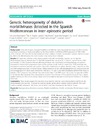Please use this identifier to cite or link to this item:
https://accedacris.ulpgc.es/jspui/handle/10553/42213
| Title: | Genetic heterogeneity of dolphin morbilliviruses detected in the Spanish Mediterranean in inter-epizootic period | Authors: | Rubio-Guerri, Consuelo Jiménez, M. Ángeles Melero, Mar Díaz-Delgado, Josué Sierra, Eva Arbelo, Manuel Bellière, Edwige N. Crespo-Picazo, Jose L. García-Párraga, Daniel Esperón, Fernando Sánchez-Vizcaíno, Jose M. |
UNESCO Clasification: | 3109 Ciencias veterinarias | Keywords: | Paramyxoviridae Endemic ocurrence Dolphin morbillivirus Stenella coeruleoalba Mediterranean striped dolphin |
Issue Date: | 2018 | Publisher: | 1746-6148 | Journal: | BMC Veterinary Research | Abstract: | Background In the last 20 years, Cetacean Morbillivirus (CeMV) has been responsible for many die-offs in marine mammals worldwide, as clearly exemplified by the three dolphin morbillivirus (DMV) epizootics of 1990–1992, 2006–2008 and 2011 that affected Mediterranean striped dolphins (Stenella coeruleoalba). Systemic infection caused by DMV in the Mediterranean has been reported only during these outbreaks. Results We report the infection of five striped dolphins (Stenella coeruleoalba) stranded on the Spanish Mediterranean coast of Valencia after the last DMV outbreak that ended in 2011. Animal 1 stranded in late 2011 and Animal 2 in 2012. Systemic infection affecting all tissues was found based on histopathology and positive immunohistochemical and polymerase chain reaction positive results. Animal 3 stranded in 2014; molecular and immunohistochemical detection was positive only in the central nervous system. Animals 4 and 5 stranded in 2015, and DMV antigen was found in several tissues. Partial sequences of the DMV phosphoprotein (P), nucleoprotein (N), and hemagglutinin (H) genes were identical for Animals 2, 3, 4, and 5, and were remarkably different from those in Animal 1. The P sequence from Animal 1 was identical to that of the DMV strain that caused the epizootic of 2011 in the Spanish Mediterranean. The corresponding sequence from Animals 2–5 was identical to that from a striped dolphin stranded in 2011 on the Canary Islands and to six dolphins stranded in northeastern Atlantic of the Iberian Peninsula. Conclusions These results suggest the existence of an endemic infection cycle among striped dolphins in the Mediterranean that may lead to occasional systemic disease presentations outside epizootic periods. This cycle involves multiple pathogenic viral strains, one of which may have originated in the Atlantic Ocean. | URI: | https://accedacris.ulpgc.es/handle/10553/42213 | ISSN: | 1746-6148 | DOI: | 10.1186/s12917-018-1559-0 | Source: | Bmc Veterinary Research [ISSN 1746-6148], v. 14, Article number 248 |
| Appears in Collections: | Artículos |
SCOPUSTM
Citations
11
checked on Jun 8, 2025
WEB OF SCIENCETM
Citations
10
checked on Jun 8, 2025
Page view(s)
95
checked on Aug 17, 2024
Download(s)
114
checked on Aug 17, 2024
Google ScholarTM
Check
Altmetric
Share
Export metadata
Items in accedaCRIS are protected by copyright, with all rights reserved, unless otherwise indicated.
